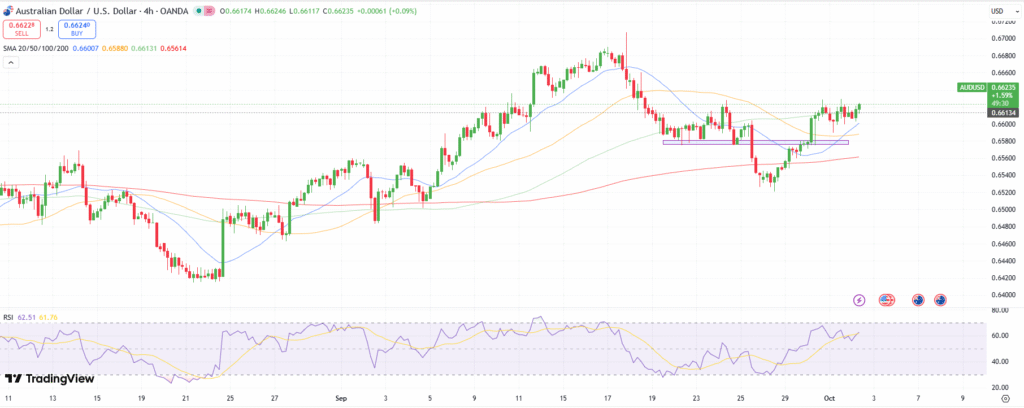October 1, 2025 – The United States stock market stands at a fascinating crossroads, celebrating a historic accumulation of wealth and recent record-setting rallies, even as it grapples with the immediate uncertainties of a federal government shutdown. On October 1, 2025, major indices presented a mixed picture, with the Dow Jones Industrial Average (DJIA) and S&P 500 (SPX) experiencing slight dips, while the Nasdaq Composite (IXIC) surprisingly edged higher. This immediate volatility underscores a broader market sentiment characterized by both profound optimism driven by robust corporate earnings and technological advancements, and a palpable caution stemming from elevated valuations and political gridlock.
Despite the day’s mixed performance, the third quarter of 2025 concluded with remarkable strength, propelling the S&P 500 (SPX) to new all-time highs. This sustained upward trajectory has significantly bolstered American households’ wealth, with an unprecedented 45.4% of assets now invested in corporate equities. This historic exposure to the stock market reflects a long-term trend of wealth creation, fueled by resilient economic performance and an accommodative monetary policy from the Federal Reserve, yet the current government shutdown introduces a fresh layer of complexity, challenging the market’s seemingly unstoppable momentum.
Market Rallies and the Shadow of a Shutdown
The recent performance of the US stock market has been nothing short of historic, with both the S&P 500 (SPX) and the Dow Jones Industrial Average (DJIA) reaching new all-time highs in the days leading up to October 1, 2025. The S&P 500 (SPX) notably climbed to 6,711.20, surpassing its previous peak, while the Dow (DJIA) added 43.21 points to hit 46,441.10, also a fresh record. These rallies are largely attributed to a combination of factors: resilient corporate earnings, particularly from mega-cap technology companies, and an ongoing accommodative stance from the Federal Reserve, which initiated interest rate cuts in late 2024 and continued into 2025, lowering the benchmark rate to a range of 4.00%-4.25% by September 2025.
However, the celebratory mood on Wall Street was tempered on October 1, 2025, by the onset of a federal government shutdown, the first in nearly seven years. This political impasse immediately introduced a layer of uncertainty, causing stock futures to dip across all major indices earlier in the day. While the Nasdaq Composite (IXIC) managed to close up 0.46%, the Dow (DJIA) fell 0.65% to 46,247.29, and the S&P 500 (SPX) dropped 0.35% to 6,664.94. The timeline leading up to this moment saw robust gains throughout Q3 2025, with the S&P 500 (SPX) gaining approximately 7% and the Nasdaq Composite (IXIC) surging 17.3% year-to-date. Key players involved in this dynamic include the Federal Reserve, whose monetary policy continues to be a significant market driver, and Congress, whose inability to pass a funding bill directly triggered the shutdown.
Initial market reactions to the shutdown have been relatively measured, but concerns are mounting over the potential for prolonged economic data delays. Crucial reports such as the September labor report and the consumer price index, vital for assessing economic health and guiding future Federal Reserve policy, are now on hold. This absence of critical information could complicate the Fed’s upcoming interest rate decisions, especially given expectations for another rate cut in October following a weaker-than-expected ADP jobs report. Meanwhile, investors have sought refuge in safe-haven assets, with gold prices surging to new all-time highs above $3,890 per ounce, reflecting a heightened demand for security amidst political instability.
Companies Navigating the Current Climate
The current market environment, characterized by record rallies, high valuations, and the new variable of a government shutdown, creates a distinct landscape of potential winners and losers among public companies. Mega-cap technology companies, particularly those involved in artificial intelligence, have been the primary beneficiaries of the recent rallies. Companies like NVIDIA (NASDAQ: NVDA), Microsoft (NASDAQ: MSFT), and Alphabet (NASDAQ: GOOGL) have seen their valuations soar, driven by strong earnings and investor enthusiasm for their growth prospects in the AI space. The communication services and technology sectors, in general, have outperformed, with gains of 12.75% and 12.4% respectively in Q3 2025, indicating continued investor confidence in their innovation and market dominance. These companies are likely to continue their strong performance as long as technological advancements and robust demand persist.
On the other hand, the government shutdown introduces a new layer of risk, particularly for companies heavily reliant on government contracts or regulatory approvals. Defense contractors, IT service providers to federal agencies, and healthcare companies that interact significantly with government programs could face delays in payments, new contract awards, or regulatory clearances. While the immediate impact might be contained, a prolonged shutdown could disrupt their operational cash flows and project timelines. Small-cap companies, as measured by the Russell 2000 (RUT), which have also seen a respectable 9.3% increase year-to-date, might be more vulnerable to economic uncertainties stemming from the shutdown due to their often-tighter financial margins and less diversified revenue streams.
Furthermore, companies in sectors sensitive to consumer spending and economic sentiment could also face headwinds if the shutdown creates prolonged uncertainty or impacts consumer confidence. Retailers, hospitality, and travel companies might see reduced demand if federal workers face pay disruptions or if the overall economic outlook darkens. The financial sector, while benefiting from an accommodative Fed, could also experience increased volatility and reduced trading volumes if market uncertainty persists. Investors are likely to scrutinize company balance sheets and revenue diversification to identify those best positioned to weather potential economic turbulence caused by the political climate.
Broader Significance and Market Dynamics
The current state of the US stock market, marked by record highs and historic wealth accumulation despite immediate political headwinds, fits into several broader industry trends. The most prominent is the ongoing dominance of technological innovation, particularly in artificial intelligence. This trend has not only propelled tech giants to unprecedented valuations but has also begun to reshape industries across the board, from healthcare to manufacturing. The market’s resilience, even in the face of concerns like inflation and geopolitical tensions, suggests a deep-seated belief in the transformative power of these technologies and the underlying strength of the US economy.
The potential ripple effects of these dynamics are significant. Competitors in traditional industries are under increasing pressure to adapt and integrate new technologies or risk being left behind. Partners in the supply chain of tech giants are benefiting from increased demand, while those tied to slower-growth sectors may find themselves struggling. Regulatory bodies are also grappling with the implications of this rapid technological evolution, with ongoing debates around antitrust, data privacy, and the ethical use of AI likely to intensify. The government shutdown, while a distinct event, could also have regulatory implications, potentially delaying crucial policy decisions or the implementation of new rules that could impact various sectors.
Historically, periods of significant market rallies coupled with elevated valuations have often preceded periods of correction. The S&P 500’s (SPX) current forward price-to-earnings (P/E) ratio of 23x, matching its 2021 cycle high and approaching the dot-com boom’s 25x peak, has led some experts to suggest the market might be in “bubble territory.” This raises comparisons to the late 1990s, where similar enthusiasm for new technologies led to unsustainable valuations. However, proponents argue that today’s market strength is underpinned by genuine earnings growth and a broader base of innovation, unlike some of the more speculative ventures of the past. The accommodative monetary policy, with continued interest rate cuts, also differentiates this period, providing a tailwind that was absent in some previous market cycles.
What Comes Next: Navigating Opportunities and Challenges
Looking ahead, the US stock market faces a fascinating interplay of short-term volatility and long-term potential. In the short term, the duration and resolution of the government shutdown will be paramount. A swift resolution could lead to a quick rebound in market confidence, while a prolonged impasse could exacerbate economic uncertainties, potentially leading to increased market pullbacks of 5-10% as some analysts fear. Investors will be closely watching for any signs of progress in Congress and the re-initiation of economic data releases, which are crucial for informed decision-making. The Federal Reserve’s next moves regarding interest rates will also be critical, with the absence of official jobs data potentially complicating their October decision.
In the long term, the underlying trends of technological innovation, particularly in AI, and the continued strength of corporate earnings are expected to remain powerful drivers. This suggests continued opportunities in growth-oriented sectors and companies at the forefront of these advancements. However, the challenge lies in navigating elevated valuations and potential market corrections. Strategic pivots or adaptations required for companies will include a continued focus on efficiency, innovation, and resilient supply chains to withstand economic shocks. Diversification, including investments in alternative assets like gold, will become increasingly important for investors seeking to mitigate risks.
Potential scenarios and outcomes range from a continued “soft landing” for the economy with sustained market growth, albeit with periodic corrections, to a more significant market downturn if inflation proves stickier than expected or if geopolitical tensions escalate. The current market is priced for perfection, meaning any significant negative surprise could trigger a substantial re-evaluation of asset prices. Market opportunities may emerge in sectors that are currently undervalued or those poised for growth from evolving consumer behaviors or regulatory shifts. Conversely, challenges include managing portfolio risk in a high-valuation environment and adapting to potential shifts in monetary policy or global economic conditions.
A Market in Transition: Key Takeaways and Future Outlook
The US stock market, as of October 1, 2025, presents a compelling narrative of unprecedented wealth accumulation and record-setting rallies, juxtaposed with immediate political uncertainties. The key takeaway is the market’s remarkable resilience, driven by robust corporate earnings, particularly in the technology sector, and a supportive monetary policy from the Federal Reserve. This has led to a historic level of household investment in equities, signaling strong long-term confidence in the market’s ability to generate wealth. However, the ongoing government shutdown serves as a potent reminder of external risks that can inject volatility and uncertainty, even into an otherwise bullish environment.
Moving forward, the market is poised for a period of careful navigation. While the long-term outlook remains generally positive due to innovation and economic fundamentals, investors must be prepared for potential short-term turbulence. The assessment of the market moving forward hinges on several factors: the resolution of the government shutdown, the trajectory of inflation, future Federal Reserve policy decisions, and the continued earnings performance of public companies. The elevated valuations, particularly in tech, suggest a need for vigilance, as the market may be susceptible to corrections if earnings growth falters or if economic data deteriorates unexpectedly.
Final thoughts on the significance and lasting impact point to a market that is evolving, driven by profound technological shifts but also sensitive to political and economic stability. The historic wealth accumulation underscores the enduring power of equity investments for long-term growth, but also highlights the importance of prudent risk management. Investors should watch for several key indicators in the coming months: the pace of inflation and the Federal Reserve’s response, the resolution and economic impact of the government shutdown, and the ongoing corporate earnings reports for signs of sustained growth or potential slowdowns. Diversification and a focus on fundamentally strong companies will be crucial strategies in this dynamic and complex market landscape.
This content is intended for informational purposes only and is not financial advice.


